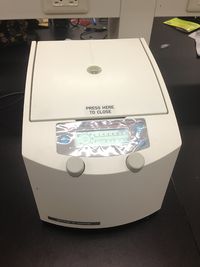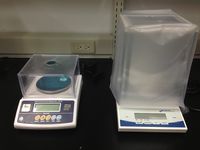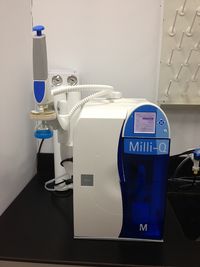Team:NCTU Formosa/Safety
From 2014.igem.org
(→2.incubator) |
(→2.incubator) |
||
| Line 48: | Line 48: | ||
[[File:NCTU FORMOSA WIKI SAFETY incubator.JPG|200px|left]] | [[File:NCTU FORMOSA WIKI SAFETY incubator.JPG|200px|left]] | ||
The orbital shaker incubator is widely used in microbiology labs, cell biology labs, etc. It provides a stationary temperature to cultivate bacteria and cells. Some incubator also have functions to maintain the humility level. | The orbital shaker incubator is widely used in microbiology labs, cell biology labs, etc. It provides a stationary temperature to cultivate bacteria and cells. Some incubator also have functions to maintain the humility level. | ||
| - | In our lab, the incubator provides stationary temperature at 37 degrees Celsius, which is the optical temperature of E.coli growing, and 16 degrees Celsius for ligase working< | + | In our lab, the incubator provides stationary temperature at 37 degrees Celsius, which is the optical temperature of E.coli growing, and 16 degrees Celsius for ligase working<sup>2</sup>. |
In this year, our team was authorized to work with an non-pathogenic bacterial strain, the Escherichia coli DH5. The strain is regularly employed in research, industry and study. Biosafety Level 1 standard regulations were strictly followed while using these strains.</p> | In this year, our team was authorized to work with an non-pathogenic bacterial strain, the Escherichia coli DH5. The strain is regularly employed in research, industry and study. Biosafety Level 1 standard regulations were strictly followed while using these strains.</p> | ||
Revision as of 03:25, 12 September 2014
Contents |
Researcher Safety
1.Everyone must wear lab coat, trousers, gloves, surgery masks and shoes when carrying out experiments.
2.Before the commencement of our project,our team instructors and advisers have guided us to go through every expiriment to make sure everybody is well trained and fit for this project.
3.Everybody has to sterilize his/her hands and all the equipment platforms with alcohol solution(70%) before and after each expiriment.
4.Emergency equipments are well prepared and all the researchers understand how to use these equipments and their exact position.
5.It is not allowed that researcher carries experiment alone.There must be at least two members to conduct the experiment.
6.Food and beverages are not allowed to appear in the lab.
Public safety
1.All collected lab waste are sterilized, packaged and executed.
2.E.coli used in our lab is less competitive than wild type, because they are unable to form biofilms and to thrive in the intestine.
3.Liquid waste that contains E.coli is disinfected by adding peroxides and cleaners before it is disposed.
Instruments in our lab
1.Centrifuge
A centrifuge is a kind of equipment generally driven by an electric motor.By rotating in very high speed, it produces a big centrifugal force perpendicular to the axis and rotates an object around a fixed axis. A centrifuge is used to separate the components which have different molecular weight in a mixture. The centrifuge works with the sedimentation principle, where the centripetal acceleration causes denser substances to separate out along the radial direction (the bottom of the tube). Conversely lighter objects will tend to move to the top.1
In our lab, we usually separate E.coli from LB broth and then conduct mini-prep with it.2.incubator
The orbital shaker incubator is widely used in microbiology labs, cell biology labs, etc. It provides a stationary temperature to cultivate bacteria and cells. Some incubator also have functions to maintain the humility level. In our lab, the incubator provides stationary temperature at 37 degrees Celsius, which is the optical temperature of E.coli growing, and 16 degrees Celsius for ligase working2.
In this year, our team was authorized to work with an non-pathogenic bacterial strain, the Escherichia coli DH5. The strain is regularly employed in research, industry and study. Biosafety Level 1 standard regulations were strictly followed while using these strains.3.Autoclave
An autoclave is a pressure chamber used to sterilize equipment and supplies by subjecting them to high pressure saturated steam at 121 °C for around 15–20 minutes depending on the size of the load and the contents. The autoclave is used for the safety issue. When sterilizing, the pressure and temperature inside reached high level, forming superheat steam and high pressure which will kill cell and make proteins destroyed or denatured.
In our lab, every equipment may contact bacteria will be sterilized before and after use to guarantee the safety.
4.Laminar flow
A laminar flow is an enclosed, ventilated laboratory workspace for safely working with materials contaminated with (or potentially contaminated with) pathogens requiring a defined biosafety level.we usually conduct experiments where our E.coli will expose, such as selecting single colony. 5 We strictly rule that all of the researchers should conduct experiments carefully inside the laminar flow and sterilize his/her hands with alcohol solution(70%) before conducting experiments, all of us are familiar with the using method of Laminar flow.
5.Balance
<p>
An analytical balance is a class of balance used in measuring small mass in the sub-milligram range. The measuring pan of an analytical balance is inside a transparent enclosure with doors so that dust can be collected well and so any air currents in the room do not affect the balance's accuracy.3
In our lab, we have two models of balance, one is accurate to 0.1 g, another is accurate to 0.1 mg.
6.Water purify system
In this system, Water is purified in a first step using unique Jetpore ion-exchange resin, synthetic activated carbon and UV lamp emitting at 185 and 254 nm to reach a resistivity of 18.2 MΩ.cm at 25 °C and a TOC value below 5 ppb, both monitored by advanced analytical techniques.4
The water purify system is used to produce ultrapure water, which is for experimental use in our lab.7.Thermal cycler
The thermal cycler (also known as a thermocycler, PCR machine or DNA amplifier) is a laboratory apparatus that are most commonly used to amplify segments of DNA via the polymerase chain reaction (PCR). The function of thermal cycle is to provide the appropriate working temperature for some reactions, including many temperature-sensitive reactions such as restriction enzyme digestion or rapid diagnostics. The device has a thermal block with holes where tubes holding the reaction mixtures can be inserted. The cycler then raises and lowers the temperature of the block in discrete, pre-programmed steps, and time setting determines the time interval of every temperature2
8.Gel Documentation System
Gel documentation system, also known as a gel image system or gel imager, is equipment widely used in molecular biology laboratories for the imaging and documentation of nucleic acid and protein suspended within polyacrylamide or agarose gels. These gels are typically stained with ethidium bromide or other fluorophores such as SYBR Green. Generally, a gel doc includes an ultraviolet (UV) light transilluminator, a hood or a darkroom to shield external light sources and protect the user from UV exposure, and a CCD camera for image capturing
Reference
- Centrifuge, Wikipedia,http://en.wikipedia.org/wiki/Centrifuge
- Incubator (culture), Wikipedia,http://en.wikipedia.org/wiki/Incubator_(culture)
- Thermal cycler ,Wikipedia,http://en.wikipedia.org/wiki/Thermal_cycler
- Autoclave ,Wikipedia,http://en.wikipedia.org/wiki/Autoclave
- Analytical balance, Wikipedia,http://en.wikipedia.org/wiki/Analytical_balance
- Milli-Q Direct, Millipore,http://www.millipore.com/catalogue/module/C85358
- Laminar flow (Biosafety cabinet), Wikipedia,http://en.wikipedia.org/wiki/Biosafety_cabinet
- Gel Documentation System, http://www.fisherbiotec.com.au/shop/product/e-box_vx5_gel_documentation_system/3. Wikipedia, http://en.wikipedia.org/wiki/Gel_doc
2014 Safety Form
<a class="gallery slidea" href="#nogo" title="Fishes" tabindex="1"><img src="  " alt="Fishes" title="Fishes" />
" alt="Fishes" title="Fishes" />
NCTU_Formosa_2014_Safty11.JPG
Photographs courtesy of morgueFile.com</a>
<a class="gallery slidea" href="#nogo" title="Fishes" tabindex="1"><img src="  " alt="Fishes" title="Fishes" />
" alt="Fishes" title="Fishes" />
NCTU_Formosa_2014_Safty11.JPG
Photographs courtesy of morgueFile.com</a>
<a class="gallery slidea" href="#nogo" title="Fishes" tabindex="1"><img src=" 
NCTU_Formosa_2014_Safty11.JPG
Photographs courtesy of morgueFile.com</a>
 "
"







